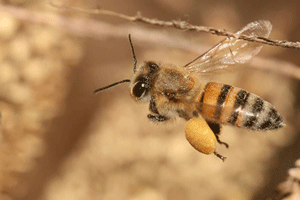Current Events in Earth Science
Endangered Honey Bees
Current Events in Earth Science
This current events in Earth Science article discusses the endangered honey bees and what is happening to the colonies of honey bees in America. The European Honeybee (honey bee) first arrived on the North American continent in 1620. Hives of bees were brought over by early colonists when they came to America almost 400 years ago. Over the years the number of honey bees has steadily increased in numbers while the wild bee populations have steadily decreased.
4000 Bee species
There are over 4000 bee species that are native to North America. The number and variety of these bee species has declines as their habitat has been destroyed. Large scale farming has increased destroying much of the wild bee's habitat.
Farmers are farming all the land they own and are starting to reduce the number of fence rows and trees in areas where once the land was suitable habitat for bees. Also urban development that was once farmland or timberland has been reduced as more people are building house in these areas.
 Honey bee returning to its hive.Photo by Muhammad Mandi Karen
Honey bee returning to its hive.Photo by Muhammad Mandi KarenTraveling honey bees pollinating crops
Farmers working to improve the amount of food they produce per acre have used traveling beekeepers that have only hives of honey bees to pollinate their crops. Today this single species of insects pollinates over 100 major crops in the United States. The food produced by these crops is 30% of the food produced in the United States.
Bee hives have problems for 10 years
Approximately ten years ago beekeepers began reporting problems with their bees. The of 2006 Dave Hackenberg reported that 360 of his 400 beehives were lifeless. The hives contained pollen, honey and larvae but no live bees were found in the hive. The bees had just disappeared.
Colony Collapse Disorder (CCD)
The next winter other beekeepers reported up to 90% of their hives had lost their bees. Colony Collapse Disorder (CCD) was coined to describe what happened to the bees living in the beehives. The bees just seemed to fly away from the hive leaving the queen and the larvae behind and never coming back.
What is suspected causing Colony Collapse Disorder
More bad news followed with other diseases suspected of killing the honeybees. Huge losses have continued during the last few years. Beekeepers are seeing a major decline in the number of hives. They believe it is a combination of loss of habitat, new parasites attacking the bees and the pesticides that are causing the Colony Collapse Disorder in the bees.
More Links to Science Articles
Current Events in Science - NASA’s New Moon Mission
Current Events in Earth Science - Endangered Honey Bees
Kids Current Events - Saving the Birds
Science Articles for Kids - Shield Volcanoe - Tamu Massif
Science Inventions Global Positioning System (GPS)
KIDS FUN SCIENCE BOOKSTORE
 |
 |
Check out Myrna Martin's award winning textbooks, e-books, videos and rock sets. The Kids Fun Science Bookstore covers a wide range of earth science topics. Click here to browse.
Sign up to our monthly newsletter and receive our FREE eBook containing 3 fun activities that don’t appear in any of our other books!
The Kids Fun Science monthly newsletter will include the following: current events, weird and fantastic facts, a question of the month, science trivia and the latest new content from our website.
We respect your privacy and you can be assured that we will never share your email address or use it for any other purpose than to send you our newsletter.






